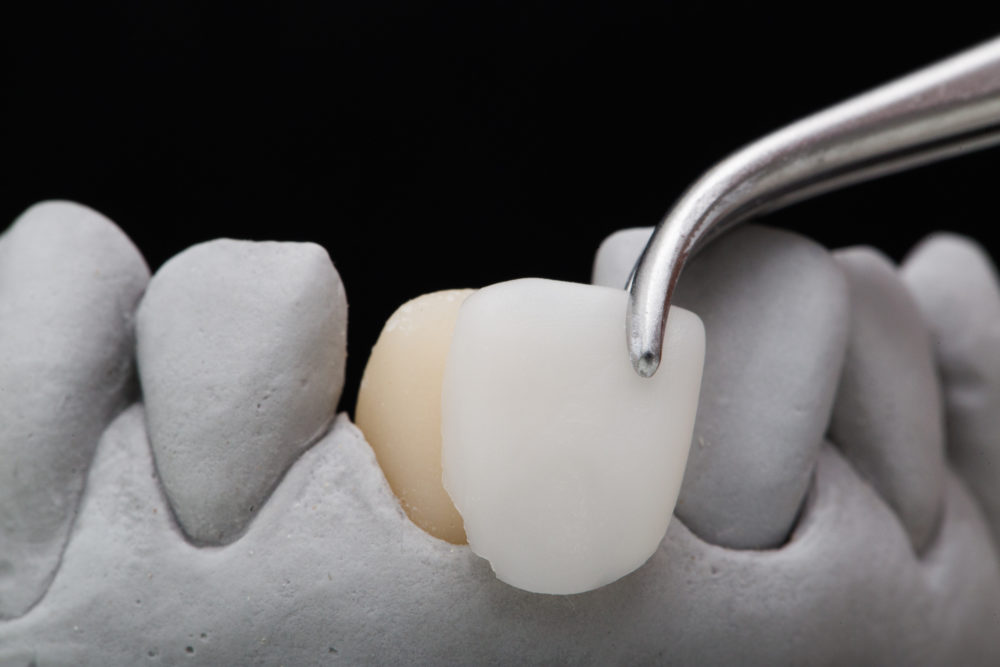
November 4, 2019
Guide to Dental Veneers
A veneer is a very thin layer of porcelain or composite resin that is bonded to a tooth, covering the tooth surface. Veneers are usually used to improve the esthetics of a tooth or multiple teeth by altering features like spacing, alignment, wearing or chipping, surface imperfections, length, shape, or discolouration. However, veneers can sometimes also be used to protect teeth or gums, or as an alternative to more extensive or costly treatments.
Types of Veneers
Veneers are categorized according to the material they are made from:
- Composite or “direct” veneers are made of composite resin. These can usually be applied in one visit, and typically last about five to seven years.
- Porcelain or “indirect” veneers are the type of veneers you will receive at Tuxedo Dental Group. Porcelain veneers are custom-made for each patient in our onsite lab, through close collaboration between our dentists and lab technicians. They are more stain resistant and also more natural-looking than composite veneers, as porcelain more closely mimics the light-reflecting properties of natural tooth material. Porcelain veneers are longer-lasting than composite veneers (at least 10 to 15 years).
The Process of Getting Veneers
Because our high-quality all-porcelain veneers are custom-made for you, you’ll need two appointments to complete the process: one to take x-rays and scans and collect all other relevant information, and the second to place your veneers. In between these two appointments, your custom veneers will be designed, fabricated, and characterized in our onsite lab, using our state-of-the-art CAD software and equipment (see our technology in action here).
In order to maintain the natural thickness and size of your tooth or teeth, your dentist will first trim about half a millimeter of tooth enamel in preparation for the veneer. When it comes time to place the veneer, your teeth will first be thoroughly cleaned, and then the tooth surface will be roughened in order to improve adhesion. Your dentist will place the veneer to make sure the fit and characterization is perfect before bonding it in place. If necessary, our onsite lab can do further characterization right in our dental chair, to make sure your veneer is perfect. The veneer will then be attached to your tooth using a special cement, and ultraviolet light will be used to quickly harden the cement and bond the veneer to your tooth.
Your dentist may want you to return for a follow-up appointment a few weeks after your veneers are placed, in order to make sure that everything is perfect and that your gums are responding well to the veneers.
Caring for Dental Veneers
Your oral hygiene will not be any different following placement of veneers. Continue to brush twice per day and floss once per day, and keep up other good oral hygiene habits as you would with natural teeth. Remember that teeth with veneers can still be vulnerable to tooth decay!
Porcelain veneers are stain-resistant, but you may want to consider avoiding staining beverages like coffee, tea, or red wine, in order to best protect your investment in veneers.
Since chip or cracks cannot be fixed, you’ll want to be extra careful to avoid chewing on hard objects or putting excessive pressure on your veneers. Habits like nail-biting or using your teeth as a tool for opening bags or cutting thread can also damage veneers. Use a non-abrasive toothpaste.
Pros and Cons of Veneers
Porcelain veneers are natural-looking and well-tolerated by the gums. It is fairly quick to achieve the result you are looking for, and the results are long-lasting. Veneers generally don’t require as much shaping of your natural tooth as a dental crown.
Some of the drawbacks of porcelain veneers are:
- The process is not reversible.
- If you clench or grind your teeth, porcelain veneers are likely not the best choice for you, as this can cause chipping or cracking. Veneers are generally not repairable if they become chipped or cracked.
- Teeth with veneers can potentially experience increased sensitivity, as some tooth enamel has been removed.
- Once placed, the colour of a veneer cannot be changed. If you plan on whitening your teeth, be sure to do so before you get veneers.
- In very rare instances, a veneer can become dislodged.
Are Veneers Right for You?
The only way to determine if veneers are the right choice for you is to book a consultation! Your dentist will do an exam, talk to you about your concerns and the results you’re looking for, and determine the best way to achieve those results. Book your consultation here.